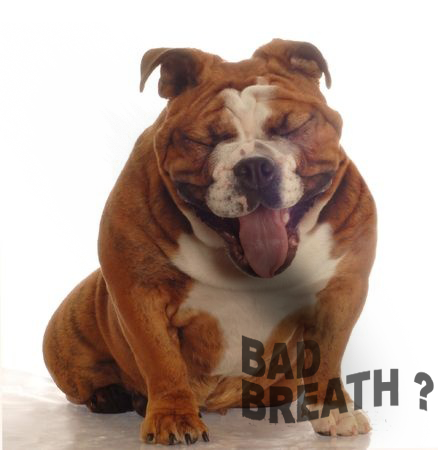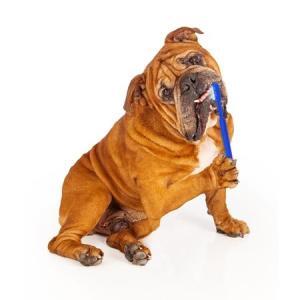How To Treat Bulldogs With Bad Breath
Imagine sitting down to enjoy a fresh cup of coffee when you detect a terrible smell. You walk around the room, looking under rugs and behind bookcases. Then, your wrinkly-faced bulldog trots up to assist with the search, panting like he always does, and you stop, realizing you’ve found the source of your woes. It was your beloved dog the whole time. As each breath plumes into the air, you know you must do something to treat it. Luckily, there are ways to get rid of the dreaded “doggy breath.”
Woah….my bulldog could use a breath mint!
There’s one thing in particular that is often the culprit giving our bulldogs foul breath. As a bulldog licks or grooms itself, hair loosens and goes straight into the mouth. These fine bits of hair have the nasty habit of gathering at the gum line. If these bits of hair go unnoticed for a time they begin to take on a foul odor giving our bully atrocious breath. Unfortunately there is nothing they can do about it on their own. This is where their human comes in to save the day. It’s a simple fix and only takes a minute to do. Go to you medicine cabinet, grab a couple of cotton swabs, and clean all hair and debris from the upper and lower gum line, rinse with water and you’re done.

How To Clean Your Bulldogs Teeth
 The most important and most obvious way to treat bad breath and prevent oral disease is to brush your dog’s teeth. What isn’t obvious, though, is how to do this without getting toothpaste on the walls because your dog refuses to let you do it. To make brushing less of a challenge, start brushing your dog’s teeth at an early age, and get him used to it by doing it every day. Begin by massaging his teeth with your fingers dipped in peanut butter. When he’s ready, introduce a toothbrush with dog-friendly toothpaste on it. There are many kinds of toothbrushes, ranging from rubber finger-sized ones to plastic ones that look similar to a human’s toothbrush. It’s a good idea to try each one to see which works best.
The most important and most obvious way to treat bad breath and prevent oral disease is to brush your dog’s teeth. What isn’t obvious, though, is how to do this without getting toothpaste on the walls because your dog refuses to let you do it. To make brushing less of a challenge, start brushing your dog’s teeth at an early age, and get him used to it by doing it every day. Begin by massaging his teeth with your fingers dipped in peanut butter. When he’s ready, introduce a toothbrush with dog-friendly toothpaste on it. There are many kinds of toothbrushes, ranging from rubber finger-sized ones to plastic ones that look similar to a human’s toothbrush. It’s a good idea to try each one to see which works best.
As is the case with brushing human teeth, there is a technique to brushing dog teeth. To start, gently grab the top of his muzzle and lift his upper lip. Brush as many outer teeth as you can by tilting the brush at an angle and using a circular motion. To make the experience positive, reward your dog with a treat or praise him if he doesn’t struggle or resist. Then, lift the upper jaw and brush the molars and insides of his teeth. If your dog starts to resist, keep your hand on his muzzle and wait until he stops to proceed. Do not force him. Repeat this process regularly, ideally on a daily basis, but at the least several times a week.
It is important to realize that brushing is only one part of preventative oral health. At home, regularly inspect your dog’s gums for signs of disease. Healthy gums are pink and not swollen. If you see redness, bleeding, swelling, growths, or tumors, or if you notice your dog drooling more, he might have a serious health problem and should be seen by a vet. During your dog’s annual check-up, have your vet inspect your dog’s teeth, and schedule a deep cleaning if necessary. Do remember that only someone familiar with English bulldogs should put your dog under anesthesia to reduce the risk of complications.

While bad breath may seem funny, in reality it is no laughing matter, especially for English bulldogs. Because of their bone structure, their teeth tend to crowd more, increasing the risk of infection. There is also a connection between oral health and overall health, so cleaning your dog’s teeth is not just about giving him a pretty smile; it could prolong his life.



